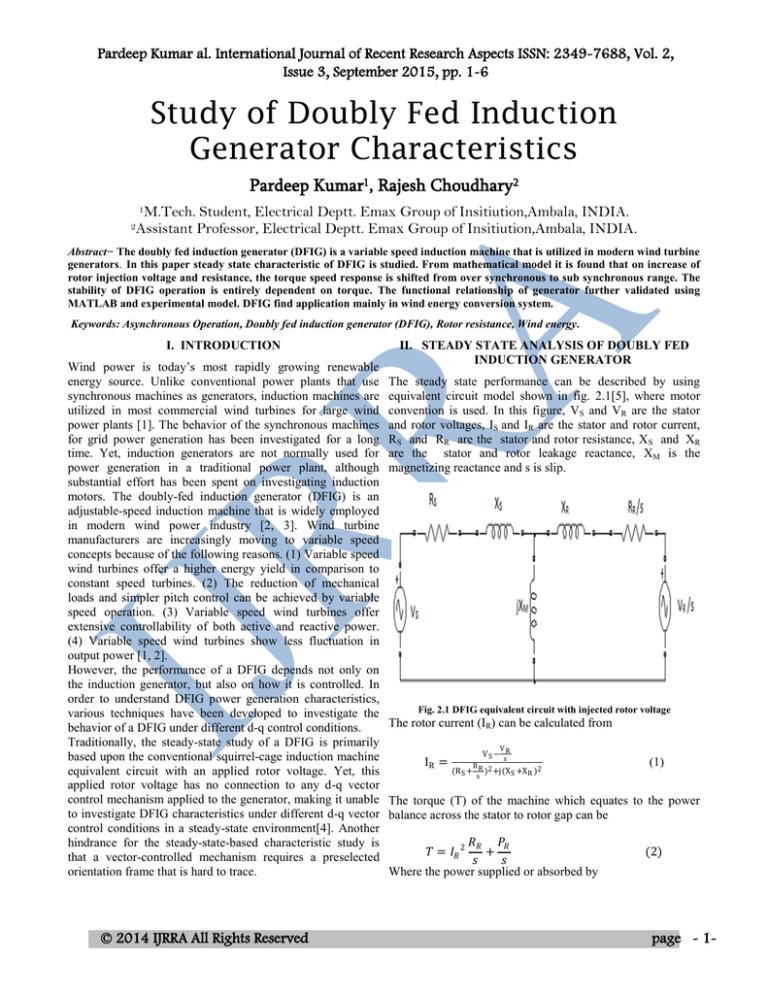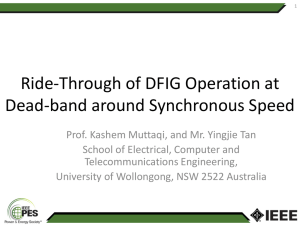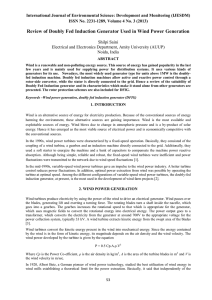
Pardeep Kumar al. International Journal of Recent Research Aspects ISSN: 2349-7688, Vol. 2,
Issue 3, September 2015, pp. 1-6
Study of Doubly Fed Induction
Generator Characteristics
Pardeep Kumar1, Rajesh Choudhary2
1M.Tech.
2Assistant
Student, Electrical Deptt. Emax Group of Insitiution,Ambala, INDIA.
Professor, Electrical Deptt. Emax Group of Insitiution,Ambala, INDIA.
Abstract− The doubly fed induction generator (DFIG) is a variable speed induction machine that is utilized in modern wind turbine
generators. In this paper steady state characteristic of DFIG is studied. From mathematical model it is found that on increase of
rotor injection voltage and resistance, the torque speed response is shifted from over synchronous to sub synchronous range. The
stability of DFIG operation is entirely dependent on torque. The functional relationship of generator further validated using
MATLAB and experimental model. DFIG find application mainly in wind energy conversion system.
Keywords: Asynchronous Operation, Doubly fed induction generator (DFIG), Rotor resistance, Wind energy.
I. INTRODUCTION
Wind power is today’s most rapidly growing renewable
energy source. Unlike conventional power plants that use
synchronous machines as generators, induction machines are
utilized in most commercial wind turbines for large wind
power plants [1]. The behavior of the synchronous machines
for grid power generation has been investigated for a long
time. Yet, induction generators are not normally used for
power generation in a traditional power plant, although
substantial effort has been spent on investigating induction
motors. The doubly-fed induction generator (DFIG) is an
adjustable-speed induction machine that is widely employed
in modern wind power industry [2, 3]. Wind turbine
manufacturers are increasingly moving to variable speed
concepts because of the following reasons. (1) Variable speed
wind turbines offer a higher energy yield in comparison to
constant speed turbines. (2) The reduction of mechanical
loads and simpler pitch control can be achieved by variable
speed operation. (3) Variable speed wind turbines offer
extensive controllability of both active and reactive power.
(4) Variable speed wind turbines show less fluctuation in
output power [1, 2].
However, the performance of a DFIG depends not only on
the induction generator, but also on how it is controlled. In
order to understand DFIG power generation characteristics,
various techniques have been developed to investigate the
behavior of a DFIG under different d-q control conditions.
Traditionally, the steady-state study of a DFIG is primarily
based upon the conventional squirrel-cage induction machine
equivalent circuit with an applied rotor voltage. Yet, this
applied rotor voltage has no connection to any d-q vector
control mechanism applied to the generator, making it unable
to investigate DFIG characteristics under different d-q vector
control conditions in a steady-state environment[4]. Another
hindrance for the steady-state-based characteristic study is
that a vector-controlled mechanism requires a preselected
orientation frame that is hard to trace.
© 2014 IJRRA All Rights Reserved
II. STEADY STATE ANALYSIS OF DOUBLY FED
INDUCTION GENERATOR
The steady state performance can be described by using
equivalent circuit model shown in fig. 2.1[5], where motor
convention is used. In this figure, VS and VR are the stator
and rotor voltages, IS and IR are the stator and rotor current,
RS and RR are the stator and rotor resistance, X S and XR
are the stator and rotor leakage reactance, XM is the
magnetizing reactance and s is slip.
Fig. 2.1 DFIG equivalent circuit with injected rotor voltage
The rotor current (IR) can be calculated from
IR =
V
VS − R
s
R
(R S + R )2 +j(X S +X R )2
(1)
s
The torque (T) of the machine which equates to the power
balance across the stator to rotor gap can be
𝑅𝑅 𝑃𝑅
+
𝑠
𝑠
Where the power supplied or absorbed by
𝑇 = 𝐼𝑅 2
(2)
page - 1-
Pardeep Kumar al. International Journal of Recent Research Aspects ISSN: 2349-7688, Vol. 2, Issue 3,
September 2015, pp. 1-6
𝑃𝑅 =
VR
I cos θ
s R
𝑃𝑅 = 𝑅𝑒(
VR
s
Simulated DFIG Stator voltage Characteristics
20
IR∗ )
15
(3)
where IR∗ is active rotor current
10
III. STEADY STATE CHARACTERISTICS OF
DOUBLY FED INDUCTION GENERATOR
-3
3
k=0.8
5
TORQUE
It is a way to investigate of operating regularities of DFIG
characteristic
curves
through
simulation.
Typical
characteristic curves of a DFIG are torque versus speed and
real power versus speed characteristics. In induction machine
those characteristics depend on the injected rotor voltage in
addition to applied stator voltage
k=1
k=0.6
k=0.4
0
-5
-10
-15
x 10
-20
-1
2
-0.6
-0.4
-0.2
0
SLIP
0.2
0.4
0.6
0.8
1
Fig. 3.2 Simulated DFIG Stator Voltage Characteristics
1
TORQUE
-0.8
Simulated DFIG Rotor Resistance Characteristics
MOTORING MODE
20
8Rr
6Rr
15
0
4Rr
10
GENRATING MODE
-1
2Rr
TORQUE
5
-2
0
-5
-3
-1
-0.8
-0.6
-0.4
-0.2
0
SLIP
0.2
0.4
0.6
0.8
1
-10
Fig.3.1 Torque speed characteristics of DFIG
A conventional fixed-speed induction machine operates in
generating mode for -1< s ≤0 and motoring mode for 0< s ≤1.
Fixed-speed induction machine, a DFIG can run both over
and below the synchronous speed to generate electricity.
Fig.3.1 shows a simulated DFIG torque-speed characteristic
for an injected rotor voltage as the operating slip varies from
s=-1 to s = 1. It can be seen from Fig.3.1, the DFIG
generating mode, corresponding to the negative torque values
can extend from negative slip (super synchronous speed) to
positive slip (sub synchronous speed).
The torque is proportional to the square of the stator supply
voltage and a reduction in stator voltage can produce a
reduction factor in speed voltage. Fig.3.2 shows torque speed
characteristics for various value of reduction factor (k).
© 2014 IJRRA All Rights Reserved
-15
-20
-4
-3
-2
-1
0
SLIP
1
2
3
4
Fig. 3.3 Simulated DFIG Rotor Resistance Characteristics
The slip at maximum torque is directly proportional to rotor
resistance Rr but the value of torque is independent of Rr.
When Rr is increased by inserting external resistance in the
rotor of a wound rotor motor, the torque is unaffected but the
speed at which it occurs can be directly controlled. The
results are shown in fig.3.3.
Fig.3.4 shows the real power as Vq increased from 0.2 to
0.6pu while Vd is kept constant at 0pu.
page - 2-
Pardeep Kumar al. International Journal of Recent Research Aspects ISSN: 2349-7688, Vol. 2, Issue 3,
September 2015, pp. 1-6
4
3
Simulated DFIG Stator Real Power Characteristics(vd=0)
x 10
STATOR REAL POWER
2
1
For high values of the injected rotor voltage, the real
power delivered to the DFIG rotor is maximum at
synchronous speed at which the DFIG rotor is equivalent
to a short circuit. A proper control of Vq and Vd is
essential to prevent high currents flowing in the rotor.
IV. CONCLUSION
From the simulation analysis it is concluded that the
DFIG characteristics are affected by its injected rotor voltage.
Within variation in amplitude of the rotor injected voltage,
the DFIG torque speed characteristics are shifted from over
synchronous to sub synchronous speed range to generate
electricity. It also increases the DFIG pushover torque,
thereby improving the stability of operation. With increase in
rotor injected voltage, the pushover power of the DFIG rises.
0
-1
vq=.2
vq=.4
-2
vq=.6
-3
-0.2
-0.15
-0.1
-0.05
0
SLIP
0.05
0.1
0.15
0.2
Fig.3.4 Simulated DFIG Stator Real Power Characteristics
(Vd =0)
Examining these curves reveals the following:
Either Vq or Vd component of the rotor injected voltage
increases positively, the DFIG real power generation
characteristics shifts more into sub synchronous speed
range.
Vq or Vd increases positively, the generation pushover
power of a DFIG rises too, showing increased DFIG
stability and power generation capability.
Vd changes from negative to positive, DFIG real power
changes gradually from flowing into (motoring) to
flowing out of (generating) the induction machine.
6
0
Simulated DFIG RotorReal power(vq=0)
x 10
REFERENCES
[1]
[2]
[3].
[3]
[4]
[5]
Ahmad M. Alkandari, Soliman Abd-Elhady Soliman, Mansour H.
Abdel-Rahman, “Steady State Analysis of a Doubly Fed Induction
Generator”, energy and power engineering,vol.3, pp. 393-400,
Sept.2011.
Zavadil, R., Miller, N., Ellis, A., and Muljadi, E., “Making connections:
Wind generation challenges and progress,” IEEE Power Energy Mag.,
Vol. 3, No. 6, pp. 22–37, November 2005.
Muller, S., Deicke, M., and De Doncker, R. W., “Doubly fed induction
generator systems for wind turbines,” IEEE Ind. Appl. Mag., Vol. 8,
No. 3, pp. 26–33, May/June 2002.
L.Piegari, R.Rizzo and P.Trricoli, “High Efficiency Wind Generator
with Variable Speed Dual Excited Synchronous Machine”,
International Conference on Clean Electrical Power 2007, Capri, pp.
795-800, 21-23 May 2007.
Sharma Pawan, Bhatti Tricholen Singh, Ramakrishana Kondapi Seha
Srinivasa “Doubly Fed Induction Generator: an Overview”, Journal of
Electrical and Electronics Engineering, vol. 3, pp.189-194, Oct 2010.
Olimpo Anaya Lara, Nick Jenkins, “Wind Energy Generation
Modeling and Control”. Wiley, 2009.
ROTOR REAL POWER
-0.5
vd=.1
vd=.2
vd=.3
-1
APPENDIX
0.37KW, Rated Voltage 380V, Rated Current 1.2A
RS (Stator Resistance) 0.083pu
XS (Stator Reactance) 0.1055pu
RR (Rotor Resistance referred to Stator side) 0.587pu
XR (Rotor Reactance referred to Stator side) 1.285pu
XM (Magnetizing Reactance) 0.0032 pu
Frequency 50 HZ
-1.5
-2
-2.5
-3
-0.2
-0.15
-0.1
-0.05
0
SLIP
0.05
0.1
0.15
0.2
Fig.3.5 Simulated DFIG Rotor Real Power Characteristics (Vq=0)
Fig.3.5 shows the real power as Vd increased from 0.1 to
0.3pu while Vq is kept constant at 0 pu. Examining these
curves reveals the following:
For both motoring and generating modes, the DFIG
sends an additional real power through its rotor as shown
in Fig. 3.5.
© 2014 IJRRA All Rights Reserved
page - 3-






